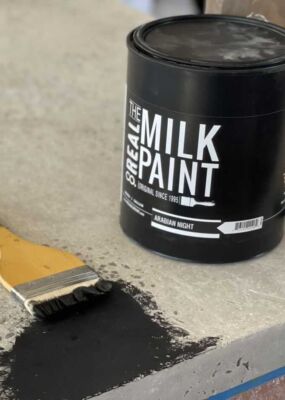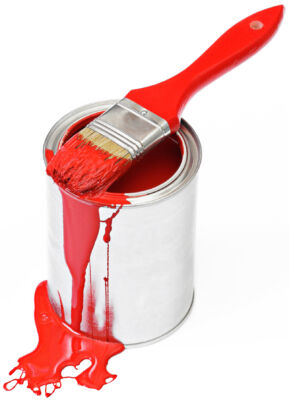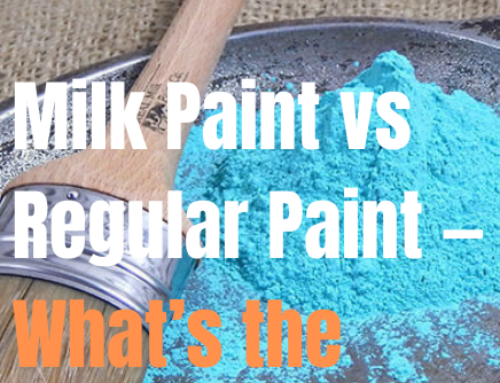 Regarding improvement and DIY projects, the choice of paint can make all the difference. With many options available, two types of paint have consistently sparked debates among enthusiasts and professionals alike: milk paint and latex paint. Both paints have unique histories, compositions, and applications, but which is truly superior? This guide examines the implications of milk and latex paint, offering insights into their differences, advantages, and ideal use cases. Whether you’re a seasoned decorator or a beginner looking to embark on a new project, understanding the distinctions between these two very different paints is crucial.
Regarding improvement and DIY projects, the choice of paint can make all the difference. With many options available, two types of paint have consistently sparked debates among enthusiasts and professionals alike: milk paint and latex paint. Both paints have unique histories, compositions, and applications, but which is truly superior? This guide examines the implications of milk and latex paint, offering insights into their differences, advantages, and ideal use cases. Whether you’re a seasoned decorator or a beginner looking to embark on a new project, understanding the distinctions between these two very different paints is crucial.
Why the Debate: Milk Paint vs. Latex Paint?
The debate between milk and latex paint isn’t just recent. It’s rooted in their historical origins, their distinct compositions, and the varied applications they offer.
Made from milk, lime, and natural pigments, milk paint was a staple for early artists and decorators. Its organic composition made it a favorite for its eco-friendly properties and the rich, matte finish it imparted. From the tombs of ancient Egypt to the early American colonial homes, milk paint has left an enduring mark on the history of art and decoration.
Latex paint, on the other hand, is a relatively modern invention. Introduced in the 20th century, it quickly gained popularity due to its water-based composition, ease of application, and quick drying time. Latex, in this context, refers to the polymer particles suspended in water, which fuse when the paint dries, forming a durable and flexible film.
Composition and Ingredients
Understanding the core components of any paint is crucial, as it directly influences its properties, application, and result. Milk and latex paint have distinct compositions that contribute to their unique characteristics.
What Makes Up Milk Paint?
Milk paint is a blend of natural ingredients, making it one of the most eco-friendly paints available. Its primary components include:
- Milk Protein (Casein): This acts as the binder, giving the paint its adhesive quality.
- Lime: Works in tandem with casein to solidify the paint and creates a new compound when dry, calcium-caseinate.
- Natural Pigments: These provide the color and can range from earthy tones to vibrant hues.
Due to its organic nature, milk paint is biodegradable. It emits zero VOCs (Volatile Organic Compounds), making it a safe choice for indoor projects, especially in spaces like nurseries or kitchens.
The Core Components of Latex Paint
Latex paint, in contrast, is a synthetic product with a more complex composition. Its main ingredients include:
- Water: Acts as the solvent, allowing the paint to be spread easily.
- Polymer Resin: This forms the paint’s film, providing durability and flexibility.
- Pigments: These give the paint its color.
- Additives: Various additives can be included to enhance properties like drying time, flow, and resistance to mold or UV rays.
While modern latex paints are formulated to be low in VOCs, particularly much lower than high-VOC oil-based paint, choosing “low-VOC” or “zero-VOC” for the most eco-friendly options is essential.
Allergies and Health Considerations
When choosing a paint, it’s not just about the finish or durability; it’s also about the potential health implications. Milk and latex paint come with their considerations, especially for those with allergies or sensitivities.
While milk paints are predominantly natural and eco-friendly, being aware of potential allergens is essential. The primary component, milk protein (casein), can be a concern for those with severe milk allergies. Some people might also be sensitive to the natural pigments or other organic compounds. Doing a patch test or consulting with a healthcare professional if you have known milk allergies before using this paint is always advisable.
The term “latex” in latex paint can be misleading. Most latex paints do not contain natural rubber latex but are made of synthetic polymers. However, some individuals might still experience reactions due to the various chemicals and compounds in the paint, especially if they are sensitive to VOCs.
Aesthetic and Finish
The visual appeal and finish play a significant role in the final look of a project. Milk and latex paint offer distinct finishes that can transform spaces.
Milk paint is renowned for its vintage, matte finish. Its natural composition often produces a slightly textured, chalky appearance, making it ideal for raw wood and rustic or antique projects.
One of the standout features of milk paint is its ability to create a “chippy” look, where the paint naturally flakes off in certain areas, giving projects an authentically aged appearance. This characteristic is especially sought after in furniture restoration or when aiming for a farmhouse-style decor.
Milk paint also works very well for walls when applied in multiple thin and even coats. For an ultra-smooth finish, you can lightly sand between coats.
Latex paint, with its synthetic composition, offers a broader range of finishes. From ultra-matte to high gloss, the choices are vast. This versatility allows various applications, from walls and ceilings to furniture and trim.
Application and Convenience
The ease of application and the convenience factor can significantly influence the choice of paint for DIY enthusiasts and professionals.
Milk paint typically comes in a powdered form, requiring mixing with water before application. However, there are pre-mixed milk paint options like those offered by Real Milk Paint Co. This allows for customizable consistency, depending on the desired finish. The paint can be thinned out for a wash-like effect or kept thicker for more opaque coverage.
Surface preparation is minimal, but a bonding agent might be necessary for non-porous surfaces to ensure proper adhesion. Brushes, rollers, or even a paint sprayer can be used for the application, but it’s essential to work quickly as milk paint dries faster than its latex counterpart.
Latex paint is ready to use straight out of the can, making it a convenient choice for many. Surface preparation involves cleaning and, in some cases, priming, especially for surfaces that might have stains or are porous. Brushes, rollers, and sprayers are all suitable for applying latex paint, offering flexibility based on the project’s size and intricacy.
Durability and Longevity
When investing time and effort into a painting project, understanding the durability and longevity of the chosen paint is crucial—milk and latex paint offer distinct advantages in this regard.
Milk paint, with its natural composition, provides a durable finish that can withstand the test of time, especially when sealed with a protective topcoat. Its matte finish is less prone to showing minor imperfections or wear over time. Milk paint can resist moisture and wear when adequately sealed, making it suitable for furniture and other high-use items. Milk paint is also naturally UV-resistant, making it the ideal choice for all your painting projects.
Latex paint is known for its resilience and longevity. Once applied and cured, it forms a flexible, durable film that can resist chipping, peeling, and fading for years. Its synthetic composition ensures it adheres well to various surfaces, protecting against environmental factors. UV-resistant formulations can further enhance the lifespan of exterior applications.
Environmental Impact and Sustainability
In today’s eco-conscious world, the environmental impact of products, including paints, is a significant consideration.
Milk paint stands out for its eco-friendly credentials. Made from natural ingredients, it’s biodegradable and free from harmful chemicals and VOCs (Volatile Organic Compounds). Its production has a lower carbon footprint than synthetic latex and oil-based paints, and its organic nature doesn’t contribute to environmental pollution. Additionally, the absence of harmful chemicals ensures that indoor air quality remains unaffected, making it a preferred choice for green building projects and eco-conscious homeowners.
Latex paint is synthetic and not naturally environmentally friendly like milk paint. It has made significant strides in becoming more environmentally friendly, and modern formulations focus on reducing or eliminating VOCs, leading to “low-VOC” or “zero-VOC” paints that minimize harmful emissions, but no matter what, latex paint still retains some harmful qualities. It’s essential to responsibly dispose of leftover latex paint, as it can harm the environment if not handled correctly.
Make an Informed Choice: Why Real Milk Paint is Superior
 In the vast landscape of paints, each type has its merits. However, when weighing the benefits and characteristics of milk paint against latex paint, several factors make milk paint stand out as the superior choice for specific applications and preferences.
In the vast landscape of paints, each type has its merits. However, when weighing the benefits and characteristics of milk paint against latex paint, several factors make milk paint stand out as the superior choice for specific applications and preferences.
- Natural Composition: Milk paint’s organic ingredients ensure you use a product free from harmful chemicals. This benefits the environment and provides better indoor air quality, making it a safer choice for homes.
- Unique Finish: The matte, chalky finish of milk paint is unparalleled. Its ability to create an authentically aged, “chippy” look is excellent for restoring and painting furniture, giving projects a rustic charm that’s hard to achieve with other paints.
- Eco-friendly: Milk paint is a green choice with zero VOCs and a biodegradable composition. Its production, use, and disposal have a minimal environmental impact, aligning with sustainable living principles.
- Versatility: While there’s a learning curve with milk paint in its powdered form, this also offers versatility. You can adjust the consistency, mix colors, and add textures, giving you creative freedom.
- Durability: Milk paint offers a durable finish that can withstand wear and tear, making it ideal for furniture and high-traffic areas, especially when you add a natural sealant like clear wax.
- Health Benefits: Milk paint’s natural composition poses fewer health risks for those with allergies or sensitivities. Its absence of synthetic chemicals and solvents ensures a safer painting experience.
While latex paint has advantages, especially in terms of convenience and a broader range of finishes, milk paint’s unique attributes make it a standout choice for those prioritizing natural ingredients, environmental impact, and a distinct aesthetic.
Choose Real Milk Paint for Your Next Project
Real Milk Paint is a leader in the milk paint industry, providing a range of milk paint colors and mixing products. Check out our paints or our other wide range of finishing products and wood oils, created with the environment and you in mind.




